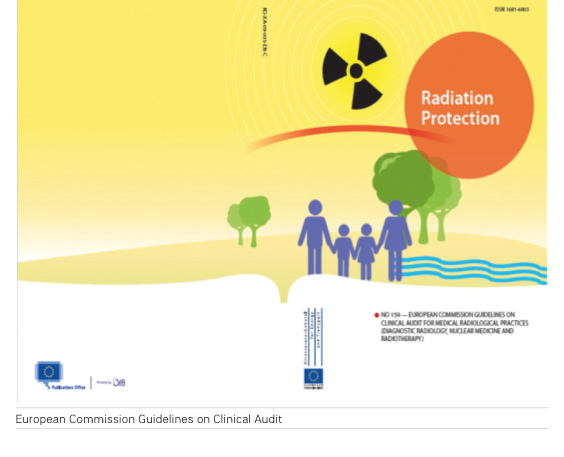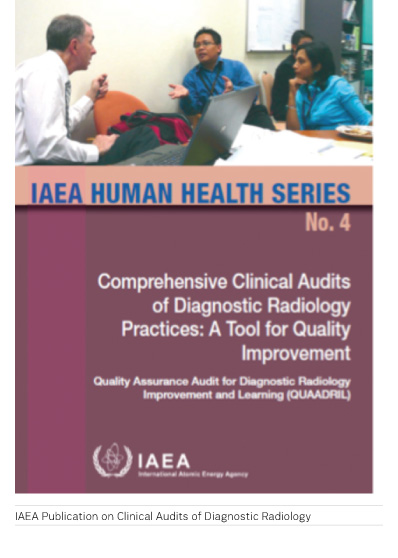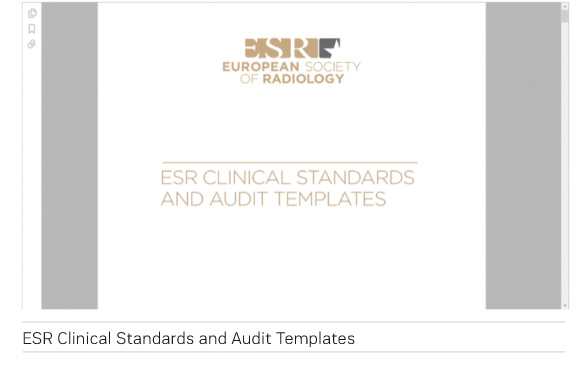HealthManagement, Volume 17 - Issue 3, 2017
Clinical audits will be mandatory for radiology departments in the EU from February 2018, but they do not need to be boring, complex or cumbersome.
Despite the fact that clinical auditing has existed for many years, the need for auditing has recently become more important. Organisations such as the European Society of Radiology (ESR), the European Commission (EC) and the International Atomic Energy Agency (IAEA) all agree on the increasing necessity of clinical audits. Legislative pressure is even more pronounced than ever: from February 2018 onwards, clinical audits will be mandatory for every European radiology department.
Upcoming Legislation
The European Council has adopted the EURATOM directive, which lays down basic safety standards for protection against the dangers arising from exposure conditions (Council Directive 2013/59/EURATOM). The establishment of quality assurance and audit programmes and inspections by the competent authorities are necessary to ensure that medical exposure is delivered under good radiation protection. The deadline is 6 February 2018; by then every member state should have defined how to perform clinical audits in radiology.
For that purpose, the European Commission (EC) published European Commission Guidelines for Clinical Audit for Medical Radiological Practices (European Commission 2009).
According to this document the definition is:
Clinical audit is a systematic examination or review of medical radiological procedures. It seeks to improve the quality and the outcome of patient care through structured review whereby radiological practices, procedures, and results are examined against agreed standards for good medical radiological procedures. Modifications of the practices are implemented where indicated and new standards applied if necessary.
A clinical audit should follow generally accepted rules and standards, the document explains. It should be systematic and involve continued activity, whereby the recommendations given in audit reports are actually implemented. Audits need to be carried out by auditors with extensive knowledge and experience of the radiological practices to be audited. The general objectives of a clinical audit should be to improve the quality of patient care, promote the effective use of resources, enhance the provision and organisation of clinical services and finally to organise professional education and training. The European guidelines also say that the detailed objectives of clinical audit should be defined related to the standards of good practice and that they need to address practical clinical work by different professionals. They should combine both internal and external assessments. For internal audits, the management of the department should set the objectives of audits. For small units the internal audit could take the form of self-assessment rather than an actual audit. For external audits, the objectives should be agreed between the auditing organisation and the healthcare unit to be audited. The objectives should be based on the audit programmes by national coordinating organisations.
You might also like: MIR 2015: Clinical Audit Can Maximise Quality, Avoid Harm
As it is not necessary to reinvent the wheel, the publication refers to an existing IAEA audit programme: Comprehensive Clinical Audits of Diagnostic Radiology Practices: A Tool for Quality Improvement: Quality Assurance Audit For Diagnostic Radiology Improvement and Learning (QUAADRI L) (International Atomic Energy Authority 2010).
QUAADRI L is well in line with the European guidelines on clinical audit, and it states:
By comparing the practice of the service against the standards of good practice, clinical audits can inform the staff of the healthcare service, as well as all other stakeholders, about the essential elements of quality and the weak points of the overall clinical service. The audits will indicate areas for improvement and provide reassurance on issues such as safety and efficacy, all of which are essential to creating an environment of continuous development.

It is a practical manual of how and what to audit, which covers the structure, processes and outcome of a radiology department. It includes chapters on: quality management procedures and infrastructure; patientrelated procedures; technical procedures, and education, training and research.
European Society of Radiology Proposal
Despite the clear value of clinical audits, some radiology departments consider audits boring, counter-productive and complex. Many organisations consider QUAADRI L as too challenging. Therefore, the ESR is proposing a phased approach. Last year, as a first step, they published the ESR Clinical Standards and Audit Templates.
The ESR believes that all radiology departments should have a clinical audit programme in order to assure users of the quality of the service and to promote continual quality improvement. To support departments in establishing an effective programme, the ESR suggests that areas for clinical audit should be categorised into three broad headings:
- Level 1 Basic Audits - These audits should be the starting
point for any audit programme and are focused on ensuring the safety of the
patient.
- Level 2 General Service Audits - These audits should be
performed in addition to the Level 1 Audits once the programme is established.
- Level 3 Focused Audits – These audits would form part of a
final comprehensive programme in departments seeking true excellence in service
provision.
Reality Check
Qaelum NV, a spin-off company from Leuven University, Belgium, received a grant from the Flemish government in order to validate a software solution allowing radiology departments to perform their own internal clinical audits, as suggested by the EC guidelines. Therefore, with a team we conducted voluntary and non-binding clinical audits according to the QUAADRI L scheme. Members of the team had experience in the field of radiology: a classic team includes a radiologist, a radiology technologist, a medical physicist and a quality specialist.
Voluntary clinical audits have now been conducted in different European countries in both university and general hospitals (25 audits in the period 2015-2016). The participating hospitals, on the one hand, were open and welcomed the project, but on the other hand they were somewhat afraid, since they didn’t know exactly what to expect. The overall initial perception of an audit is, or was, that it is very labour-intensive, a lot of people need to be involved and it costs a lot of money and precious time. In addition, during our clinical audits we noticed that many hospitals were in the middle of simultaneous accreditations or certifications.
However, although clinical audit is different from other quality assessment systems, the overall perception of the people on the floor was a kind of déja vu. While the practical procedures can be partly similar, there are clear differences in the focus of the evaluation and in the consequences of the results of the observations.
Quality audits for certification check the conformity of the local quality system to the given quality standard, and do not directly ensure good quality of the practices in terms of clinical judgments. Audits for accreditation come closest to the objectives of clinical auditing, but they are limited to standard procedures where definite standards are available. Clinical audit should be considered as supplementing and not duplicating the other efforts. The focus in clinical audits is, as a peer review activity, always on the clinical issues of the service, where comparisons with clinical good practice are relevant, and the results are recommendations with no inherent obligation on their implementation.
The goal of the Qaelum solution is to take away this burden and to reduce unnecessary overlaps with different audit and accreditation systems. This is possible by the following:
- Automating the collection of data in a reliable fashion
- Combining the available scattered data in one place to
simplify the execution of a clinical audit
- Reducing the associated costs, time and manpower increases
the reliability of the collected data and also increases the potentially
positive outcome of an actual clinical audit.
As a result, after the audit visit, the initial perception of an audit being boring, cumbersome and time consuming disappeared in the majority of the audited radiology departments. By adapting the right strategy, supported by an appropriate software solution, a full audit can be performed in 2 to 3 days with a small audit team of 2 people. In some cases, radiology departments can even audit themselves without any outside support.
Another positive finding of the clinical audits is that the overall quality of radiology departments in Europe, when compared to good practice, as defined by the different auditing and accreditation bodies, had, on average, an >80% compliance.


Conclusion
By auditing ourselves (internal audit), we become aware of how our departments are performing and how well and safely we are looking after our patients. Audit allows us to check on how we are compliant to existing good practice. It gives us information as to where improvements should be made. Through re-audit we can then check that the anticipated improvement has actually been achieved.
In the end, clinical audits can show the world how good our radiology departments really are
Key Points
- From February 2018 clinical audits will be mandatory for
European radiology departments
- Publications from the European Commission, International
Atomic Agency Authority and the European Society of Radiology provide
information on how to perform clinical audits
- The ESR proposes a phased approach with 3 levels of clinical
audit
- Qaelum NV led a project to validate a software solution for
radiology departments to carry out internal clinical audits
- Clinical audits can show the world how good our radiology
departments really are
References:
Council Directive 97/43/Euratom of 30 June 1997 on health protection of individuals against the dangers of ionizing radiation in relation to medical exposure, and repealing Directive 84/466/Euratom. [Accessed: 16 June 2017] Available from eur-lex.europa.eu/legal-content/EN/TXT/?uri=celex%3A31997L0043
Council Directive 2013/59/Euratom of 5 December 2013 laying down basic safety standards for protection against the dangers arising from exposure to ionising radiation, and repealing Directives 89/618/Euratom, 90/641/Euratom, 96/29/Euratom, 97/43/Euratom and 2003/122/Euratom. [Accessed: 16 June 2017] Available from eur-lex.europa.eu/legal-content/EN/TXT/?uri=uriserv:OJ.L_.2014.013.01.0001.01.ENG&toc=OJ:L:2014:013:TOC
European Commission (2009) European Commission guidelines on clinical audit for medical radiological practices (diagnostic radiology, nuclear medicine and radiotherapy). Radiation Protection No 159. [Accessed: 16 June 2017] Available from ec.europa.eu/energy/sites/ener/files/documents/159.pdf
European Society of Radiology; ESR Subcommittee on Audit and Standards (2010) Clinical audit-ESR perspective. Insights Imaging, 1(1): 21-6.
European Society of Radiology (2011) European Commission guidelines on clinical audit. Statement by the European Society of Radiology. Insights Imaging, 2(2): 97-8.
European Society of Radiology (2016) ESR audit tool. [Accessed: 16 June 2017] Available from myesr.org/sites/ default/files/ESR_2016_Audit-Tool.pdf
International Atomic Energy Authority (2010) Comprehensive clinical audits of diagnostic radiology practices: a tool for quality improvement. Vienna: International Atomic Energy Agency. [Accessed: 16 June 2017] Available from www-pub.iaea.org/books/ IAEABooks/8187/Comprehensive-Clinical-Audits-of- Diagnostic-Radiology-Practices-A-Tool-for-Quality- Improvement
















